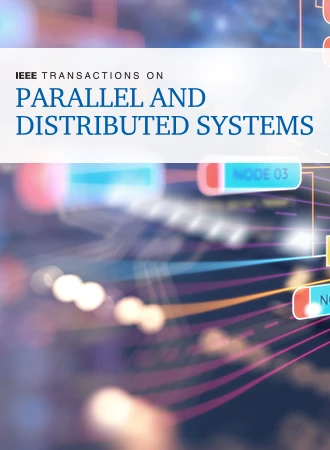A Collaborative Service Composition Approach Considering Providers’ Self-Interest and Minimal Service Sharing
IF 5.6
2区 计算机科学
Q1 COMPUTER SCIENCE, THEORY & METHODS
IEEE Transactions on Parallel and Distributed Systems
Pub Date : 2025-01-27
DOI:10.1109/TPDS.2025.3534283
引用次数: 0
Abstract
Service composition dynamically integrates various services from multiple providers to meet complex user requirements. However, most existing methods assume centralized control over all services, which is often unrealistic because providers typically prefer to independently manage their own services, posing challenges to the application of traditional methods. Collaborative service composition offers a solution by enabling providers to work together to complete service composition. However, this approach also faces its own challenges. Driven by self-interest, providers may be reluctant to offer services needed by others, and due to business competition, they may wish to share as few services as possible (where sharing services means disclosing service information to other providers). To address these challenges, we propose a novel collaborative service composition approach that comprehensively considers each provider’s self-interest and achieves service composition with minimal service sharing. First, we introduce a “self-interest degree” model to capture providers’ self-interest. This behavior may lead to service refusal, so we design a service availability prediction method based on a reputation model to minimize rejections. Then, we propose a decentralized service composition method. It utilizes historical composition records to mine empirical rules between requirements and services, constructing a correlations matrix, and collaboratively trains a multi-label classification model with other providers under a distributed federated learning framework. Combining the matrix and model outputs, we design a service composition method and a node coordination protocol that completes service composition with minimal service sharing. Experimental results demonstrate the effectiveness of the proposed method in capturing providers’ self-interest and showcase its superior performance compared to existing methods.考虑提供者自利和最小服务共享的协同服务组合方法
服务组合动态地集成来自多个提供者的各种服务,以满足复杂的用户需求。然而,大多数现有方法都假定对所有服务进行集中控制,这通常是不现实的,因为提供者通常更喜欢独立管理自己的服务,这对传统方法的应用提出了挑战。协作式服务组合通过支持提供者一起工作来完成服务组合,从而提供了一种解决方案。然而,这种方法也面临着自身的挑战。在自身利益的驱使下,提供者可能不愿意提供他人需要的服务,并且由于商业竞争,他们可能希望尽可能少地共享服务(其中共享服务意味着向其他提供者披露服务信息)。为了应对这些挑战,我们提出了一种新的协作式服务组合方法,该方法综合考虑了每个提供者的自身利益,并以最小的服务共享实现了服务组合。首先,我们引入了一个“自利度”模型来捕捉提供者的自利。这种行为可能导致服务拒绝,因此我们设计了一种基于声誉模型的服务可用性预测方法来最小化拒绝。然后,我们提出了一种分散的服务组合方法。它利用历史组合记录挖掘需求和服务之间的经验规则,构建关联矩阵,并在分布式联邦学习框架下与其他提供者协作训练多标签分类模型。结合矩阵和模型输出,设计了一种服务组合方法和节点协调协议,以最小的服务共享完成服务组合。实验结果表明,该方法能够有效地捕获提供者的自利,并且与现有方法相比具有更优越的性能。
本文章由计算机程序翻译,如有差异,请以英文原文为准。
求助全文
约1分钟内获得全文
求助全文
来源期刊

IEEE Transactions on Parallel and Distributed Systems
工程技术-工程:电子与电气
CiteScore
11.00
自引率
9.40%
发文量
281
审稿时长
5.6 months
期刊介绍:
IEEE Transactions on Parallel and Distributed Systems (TPDS) is published monthly. It publishes a range of papers, comments on previously published papers, and survey articles that deal with the parallel and distributed systems research areas of current importance to our readers. Particular areas of interest include, but are not limited to:
a) Parallel and distributed algorithms, focusing on topics such as: models of computation; numerical, combinatorial, and data-intensive parallel algorithms, scalability of algorithms and data structures for parallel and distributed systems, communication and synchronization protocols, network algorithms, scheduling, and load balancing.
b) Applications of parallel and distributed computing, including computational and data-enabled science and engineering, big data applications, parallel crowd sourcing, large-scale social network analysis, management of big data, cloud and grid computing, scientific and biomedical applications, mobile computing, and cyber-physical systems.
c) Parallel and distributed architectures, including architectures for instruction-level and thread-level parallelism; design, analysis, implementation, fault resilience and performance measurements of multiple-processor systems; multicore processors, heterogeneous many-core systems; petascale and exascale systems designs; novel big data architectures; special purpose architectures, including graphics processors, signal processors, network processors, media accelerators, and other special purpose processors and accelerators; impact of technology on architecture; network and interconnect architectures; parallel I/O and storage systems; architecture of the memory hierarchy; power-efficient and green computing architectures; dependable architectures; and performance modeling and evaluation.
d) Parallel and distributed software, including parallel and multicore programming languages and compilers, runtime systems, operating systems, Internet computing and web services, resource management including green computing, middleware for grids, clouds, and data centers, libraries, performance modeling and evaluation, parallel programming paradigms, and programming environments and tools.
 求助内容:
求助内容: 应助结果提醒方式:
应助结果提醒方式:


